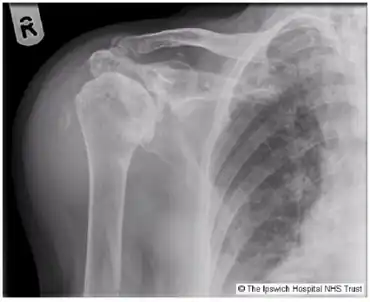Milwaukee shoulder syndrome
| Milwaukee shoulder syndrome | |
|---|---|
 | |
| Milwaukee shoulder syndrome X-ray. | |
| Specialty | Rheumotology |
Milwaukee shoulder syndrome (MSS) (apatite-associated destructive arthritis/Basic calcium phosphate (BCP) crystal arthritis/rapid destructive arthritis of the shoulder[1] is a rare[2] rheumatological condition similar to pseudogout, associated with periarticular or intra-articular deposition of hydroxyapatite or basic calcium phosphate (BCP) crystals. While primarily associated with the shoulder joint, it can affect any joint in the body below the head.[3] Along with symptomatology, the disease typically presents with positive radiologic findings, often showing marked erosion of the humeral head, cartilage, capsule, and bursae. Though rare, it is most often seen in females beginning in their 50s or 60s. Patients often have a history of joint trauma or overuse, calcium pyrophosphate dehydrate crystal deposition, neuroarthropathy, dialysis-related arthropathy or denervation.[2]
Signs and symptoms
Signs and symptoms may include the following:
- Limited active range of motion, usually unrestricted passive range of movement (early)
- Joint pain
- Joint inflammation and tenderness
- Synovial hemorrhagic effusion/hematoma
- Radiologic positive findings[4]
- Hydroxyapatite crystals in synovial fluid
Causes
Hydroyapatite crystal deposition in the joint causes the release of collagenases, serine proteases, elastases, and interleukin-1. This leads to acute and rapid decline in joint function and degradation of joint anatomy. Subsequently, disruption of the rotator cuff ensues.[5][3]
Diagnosis
Diagnosis is made with arthrocentesis and Alizarin Red staining along with clinical symptoms.[6] X-rays, arthrography, ultrasonography, CT imaging and MRI imaging are also helpful in diagnosing this condition
Treatment
Treatment may include the prescription of one or more of the following:
- Non-steroidal anti-inflammatory drugs (NSAIDs)
- Intra-articular steroids
- Physical therapy
- Partial or complete arthroplasty
Nomenclature
According to Nadarajah and Weikert, "[t]he term Milwaukee shoulder syndrome was first used in 1981 to describe four elderly women in Milwaukee... with recurrent bilateral shoulder effusions, radiographic evidence of severe destructive changes of the glenohumeral joints, and massive tears of the rotator cuff."[2]
References
- ↑ Lequesne, M; Fallut, M; Coulomb, R; Magnet, J L; Strauss, J (1982). "L'arthropathie destructrice rapide de l'épaule" [Rapid destructive arthropathy of the shoulder]. Revue du rhumatisme et des maladies ostéo-articulaires (in French). 49 (6): 427–437. PMID 7112022. Archived from the original on 8 December 2021. Retrieved 8 December 2021.
{{cite journal}}: CS1 maint: unrecognized language (link) - 1 2 3 Nadarajah, Channa Vasanth; Weichert, Immo (2014). "Milwaukee Shoulder Syndrome (case report)". Case Reports in Rheumatology. Hindawi Limited. 2014: 458708. doi:10.1155/2014/458708. PMC 3914332. PMID 24551470.
 Text was copied from this source, which is available under a Creative Commons Attribution 3.0 (CC BY 3.0) Archived 2011-02-23 at the Wayback Machine license.
Text was copied from this source, which is available under a Creative Commons Attribution 3.0 (CC BY 3.0) Archived 2011-02-23 at the Wayback Machine license. - 1 2 Genta, Marcia S., Gambay, Cem. Milwaukee Shoulder. New England Journal of Medicine. 354;2. January 12, 2006
- ↑ "Milwaukee Shoulder Syndrome". Archived from the original on 21 January 2016. Retrieved 9 Jan 2016.
- ↑ https://archive.today/20120223034722/http://www.medcyclopaedia.com/library/topics/volume_iii_1/m/milwaukee_shoulder_syndrome/gmilwaukee_shoulder_syn_fig01.aspx Milwaukee Shoulder Syndrome], Medcyclopedia (with image), via archive.org. Accessed 2013-1-27.
- ↑ Epis O, Viola E, Bruschi E, Benazzo F, Montecucco C. Reumatismo. 2005 Apr-Jun;57(2):69-77